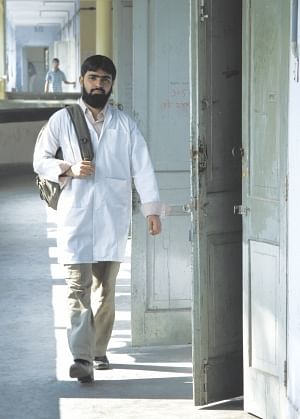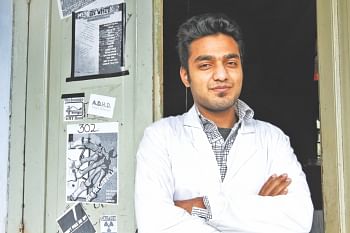| Home - Back Issues - The Team - Contact Us |
 |
| Volume 11 |Issue 04| January 27, 2012 | |
|
|
Education A Nice Surprise Every year hundreds of foreign students come to Bangladesh to study medicine. The quality and cost effectiveness of education has lured them from their motherlands Akram Hosen Mamun
There is a misconception nurtured by some that medical education in Bangladesh is so below international standards that you won't be able to pursue a career in medicine anywhere else in the world with a Bangladeshi MBBS degree. The truth is that many medical students from Bangladesh have been able to continue their education and even get jobs in some of the most prestigious medical institutions of the world. In fact, hundreds of foreign students come to Bangladesh every year to study medicine. The number of international students who apply for medical education in Bangladesh exceeds the number of vacant seats in our colleges. The authorities of Directorate General of Health Services (DGHS), understandably, have to become more selective about allowing foreign students to study medicine in Bangladesh, especially when the local demand for seats is so high. While thousands of Bangladeshi students go to great lengths for a chance to study abroad one may wonder why so many foreign students decide to come here to study. Most of the foreign medical students, even the ones at private medical colleges, say that the cost of education in Bangladesh is lower than most of the countries of the world. They also insist that the quality of medical education in this country is good. “I went to the Bangladeshi High Commission in India and submitted my educational certificates. After scrutinising my papers, they informed me that I was eligible for a scholarship to Dhaka Medical College under the SAARC scholarship quota. So I'm, studying here for free,” says Taifoor, a fourth year student from Kashmir. In a similar vein, Pakistani student Ahmed Naeem says that he always wanted to study abroad. “I sat for an entrance test in Pakistan, and then on the basis of my merit, I was awarded a scholarship to Bangladesh,” he says. In public medical institutions offering undergraduate degrees, there are some 50 seats for foreign students under the South Asian Association for Regional Cooperation (SAARC) quota and 45 seats under non-Saarc quota. The eight SAARC countries have a treaty of exchanging students among themselves. Each of these countries keeps a number of reserved seats for students from other SAARC nations. As a result, it is comparatively easier for students of one SAARC country to get admission in another country. Taifoor says, “The entrance exams of the Indian public medical colleges are really hard to pass. Since there are reserved quotas here, it was easier for me to get the chance and win the scholarship to Bangladesh.” He asserts that it is also comparatively easier for Bangladeshi students to get an admission in medical colleges in SAARC countries without having to pass the intimidating entrance exams. Waqar Aslam, another second year student from Pakistan, says that he saw the ranking of Dhaka Medical College on the internet. “Thanks to the scholarship quotas, I feel lucky to have got the chance to study here,” he says.
“I fractured my leg playing soccer before the entrance exam of medical schools in India began,” says Junaid Ahmed from India, an intern at the Dhaka Medical College Hospital (DMCH). “Due to lack of preparation I failed the exam but immediately afterwards I applied for a scholarship and as soon as I got that, I came to Dhaka from Kashmir.” He thinks that even living costs in Dhaka are lower compared to India. Private medical colleges also keep a large number of seats for foreign students of both SAARC and non-SAARC countries. Although the cost of sending their children to private medical colleges seems pretty high to most Bangladeshi parents, the foreign students assert that expenses in Bangladesh are lower than any of our neighbouring countries. Mamusha Thapa, a first year student of Khawja Yunus Ali Medical College, Sirajganj has come from Nepal. “Considering the amount one has to pay to get a quality medical education in my own country, I think Bangladesh is not expensive at all,” she says. According to Thapa, Bangladeshi medical colleges are quite popular among Nepalese parents. “Many of the Nepalese prefer Bangladeshi private medical colleges to Nepalese ones. If they decide to send their kids abroad to study medicine, it is either Bangladesh or China that they think of at first.” she says. Asked to comment on the reason why she thinks Bangladeshi institutions are widely trusted in Nepal, she says, “Many of our practicing doctors of some repute are graduates of Bangladeshi medical schools. They always advise students to come to Bangladesh to study medicine.” The private medical colleges charge no extra fees from students who fall under the SAARC quota. Nevertheless, many of these students pay a considerably large sum to the agencies that act as middlemen for students seeking admission in Bangladeshi institutions. It is through these agencies that these students and their parents get to know about different medical colleges in Bangladesh. “The families even pay the tuition fees through these agencies,” says Thapa. There is no doubt that updating the online services of these institutions and taking some other timely initiatives will let students and parents cut out the middlemen and lessen the cost of education abroad. While most of these students agree that the quality of teaching in Bangladeshi medical colleges is good, some say that too much emphasis has been placed on memorising text books with nominal focus on conceptual understanding. “In the long run, it does not help to memorise a lot of definitions and cram things in our head to pass the exams. The frequent examinations are also detrimental to the development of conceptual understanding through reading. We had to sit for an exam almost every month. I think they should focus more on the clinical sides of the study. Cutting down on the exams will give the students time to read and understand,” says Junaid. However, most of the foreign students are of the opinion that the hospitals of the medical colleges significantly facilitate learning. Medical students get hands on experience from the hospitals the colleges are part of. “The hospital of Dhaka Medical College is really huge. Students get a lot of exposure regarding the various kinds of diseases. In that respect this college is better than most of the colleges of the world,” Junaid says, “You can have a look at all sorts of diseases in this hospital even when you are a student whereas in India they don't allow students to examine any patient.” Although doctors earn a lot in Bangladesh, the number of foreign students who stay on after finishing their graduation is virtually zero. “The chances that I'll get a decent job in Kashmir after my internship here are slight. But still, I would rather be content with much less from a government job in India than earn lakhs from private chambers and clinics in Dhaka. Making a business out of the medical profession takes away the dignity and honour of this discipline,” says Junaid. Copyright (R) thedailystar.net 2012 |
||||||||

